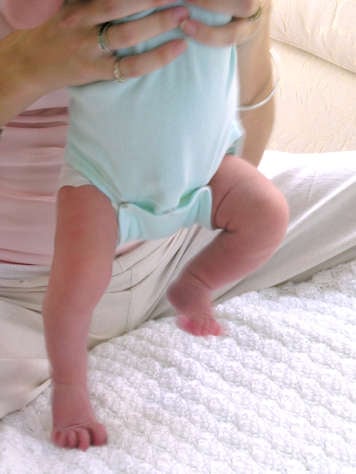The terms 'mother' and 'breast' are used throughout our documents; we recognize and respect that individuals and families may use other preferred terminology.
We tend to think of newborn babies as helpless. However, newborn babies are able to search for their mother’s breast and nurse when they do find it. Most newborn babies can breathe without assistance and cry surprisingly loudly!

First movements
In the few minutes after birth, if a newborn baby is placed in skin-to-skin contact with their mother’s chest, and their arms and legs are free to move, they will maneuver towards their mother’s nipple. To get to their mother’s breast, the newborn baby will move their legs in a stepping motion or do small push-ups with their arms to push themselves along. They may take a few rest stops along the way. When they have navigated themselves to their mother’s breast, they may decide to suck right away or, more likely, they may be interested in gazing at their mother’s eyes. This is a very moving time for most parents, if they are presented with this opportunity. However, some hospitals still prefer to wrap newborn babies tightly in swaddling cloth, which can help babies to feel safe and secure, but obviously restricts their movements. If you feel strongly about having the opportunity to experience skin-to-skin contact right after birth, be sure to discuss this with your health-care providers beforehand.
A newborn baby’s first movements may appear jerky and random. However, usually the newborn baby moves in a pattern or rhythm. For example, if the newborn baby is active and alert, they will tend to start moving their arms and legs, then slow down and stop, and repeat the process after a minute or two. Some newborn babies move more or less frequently than others. They may move in rhythm with their mother’s voice. They are able to reach for their mother’s face, although this ability disappears around three to four weeks of life and does not resurface until a few months later. By the end of the first month of life, most babies are able to lift their head briefly while lying on their stomach.
Reflexes
Newborn babies have several reflex movements at birth including rooting, crawling, grasping, startle, placing and stepping reflexes. These reflexes may begin before birth, sometimes as early as 20 weeks' gestation. Most newborn reflexes disappear during the first few months of life and are replaced by voluntary movements as babies develop new skills.
The rooting reflex
Stroke your baby’s mouth or cheek, and you will notice them turning in that direction and opening their mouth in search of a nipple. This reflex lasts into the fourth month.
The crawling reflex
If your baby is placed on their stomach, they will pull their legs under their body and kick them out in a crawling motion. In fact, when newborn babies are placed on their mother’s stomachs, they are able to crawl up to their mother’s breast and start nursing. The crawling reflex disappears after just a few weeks.

The grasping reflex
At birth, a newborn baby has such a strong grip that it is possible to lift them up entirely by their grasp. Most new parents are amazed at how strong their newborn baby’s grip really is. The grasping reflex is strongest at about two months, and gradually decreases from there. By five to six months, this reflex disappears entirely.
The startle reflex
Loud noises or sudden movements may cause your newborn baby to arch their back, throw out their arms and legs, and cry. This is called the startle, or Moro, reflex, and it will last about four months.
The placing reflex
Hold your newborn baby in an upright position in front of a table or other object. They will raise their foot to try to step onto the object, or they will raise their arm automatically.

The stepping reflex
Hold your newborn baby in a standing position on a flat surface and watch as they try to take little steps. This is a very cute reflex, but unfortunately it is short-lived. The stepping reflex usually subsides by about two months.
